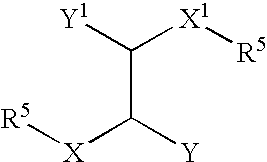Grind resin
a technology of grinding resin and grinding film, which is applied in the direction of pigment paste, etc., can solve the problems of undesirable color shift, and many grind resins of the prior art that do not respond well to mechanical forces, etc., to minimize the color shift of the cured film, improve the effect of pigmentation, and minimize the amount of pigmentation
- Summary
- Abstract
- Description
- Claims
- Application Information
AI Technical Summary
Benefits of technology
Problems solved by technology
Method used
Image
Examples
example 1
Grind Resin
[0059]In preparation for providing the grind resin, an auger, a reaction vessel with an agitator, a fractionator having a condenser and a decanter, a thindown vessel, and a filter press are provided. Diol A, Fatty Compound A, Dibasic Acid A, Dibasic Acid B, Dibasic Acid C, and Catalyst A, as described in further detail below, are loaded to the reaction vessel via the auger. The reaction vessel is purged with nitrogen and heated to 225° C. At approximately 150° C., a reaction between Diol A, Fatty Compound A, Dibasic Acid A, Dibasic Acid B, and Dibasic Acid C begins to generate a reaction product and steam. The steam rises up the fractionator and carries unreacted glycol as an azeotrope. The fractionator is maintained at a temperature of between 98 and 100° C. so that glycol separates from the steam and falls back to the reaction vessel. When the reaction product inside the reaction vessel reaches 225° C. and the temperature of the fractionator drops below 90° C., the frac...
example 2
Pigment Dispersion
[0069]A pigment dispersion of the present invention is produced by combining the grind resin of Example 1, Solvent A, and Pigment A. Prior to combination, a mixing vessel, a Cowles blade, and a high speed air motor are provided. An Eiger mill is provided for grinding Pigment A in the grind resin. The grind resin of Example 1, Solvent A, and Pigment A are added to the mixing vessel and mixed with the Cowles blade via the high speed motor for one hour to form the pigment dispersion. The pigment dispersion is passed through the Eiger mill twice.
[0070]The specific amounts of each component in the pigment dispersion are indicated below in Table 2, wherein all amounts are in parts by weight based on 100 parts by weight of the pigment dispersion.
TABLE 2ComponentExample 2Grind Resin of Ex. 137.25Solvent A11.73Pigment A51.02Total100.00
[0071]Pigment A is Ishihara TY300, commercially available from Ishihara Corporation of San Francisco, Calif.
[0072]The viscosity of the pigmen...
examples 3-5
Coating Compositions
[0074]A coating composition of the present invention is prepared. In preparation for preparing the coating composition, a first mixing vessel, a second mixing vessel, and a Waring blender are provided. A panel for draw down testing is also provided.
[0075]To prepare the coating compositions of Examples 3-5, Base A and Pigment Dispersions A-D are combined in the amounts as set forth in Table 4 in the first mixing vessel and stirred at high speed with the Cowles blade to form a first sample of the coating composition of each Example.
TABLE 4Exam-Componentple 3Example 4Example 5Base A (g)110.767110.767110.767Pigment Dispersion A (g)14.77Pigment Dispersion B (g)7.777.77Pigment Dispersion C (g)14.7714.77Pigment Dispersion D (g)7.779
[0076]Base A is a combination of a polyester resin, hexamethoxymethyl melamine commercially available under the tradename Resimene® from Solutia of St. Louis, Mo., and Aromatic 150 Fluid, commercially available from Exxon Mobil Corporation of...
PUM
| Property | Measurement | Unit |
|---|---|---|
| temperature | aaaaa | aaaaa |
| temperature | aaaaa | aaaaa |
| acid value | aaaaa | aaaaa |
Abstract
Description
Claims
Application Information
 Login to View More
Login to View More - R&D
- Intellectual Property
- Life Sciences
- Materials
- Tech Scout
- Unparalleled Data Quality
- Higher Quality Content
- 60% Fewer Hallucinations
Browse by: Latest US Patents, China's latest patents, Technical Efficacy Thesaurus, Application Domain, Technology Topic, Popular Technical Reports.
© 2025 PatSnap. All rights reserved.Legal|Privacy policy|Modern Slavery Act Transparency Statement|Sitemap|About US| Contact US: help@patsnap.com



